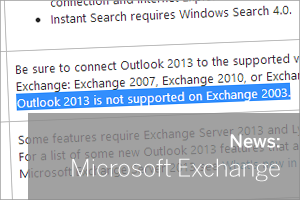27
Mar
Support queries shared: Rsync backups to QNAP failing
 If you're not already familiar with Rsync, it's the method (or 'protocol' to be posh about it) that BackupAssist uses to send data off-site to locations such as NAS boxes or to other servers.
QNAP make a NAS device that's popular with our customers and this week I came across an issue with backing up via Rsync to it that I've seen before...
...cue helpful (hopefully) blog post!
If you're not already familiar with Rsync, it's the method (or 'protocol' to be posh about it) that BackupAssist uses to send data off-site to locations such as NAS boxes or to other servers.
QNAP make a NAS device that's popular with our customers and this week I came across an issue with backing up via Rsync to it that I've seen before...
...cue helpful (hopefully) blog post!


 call time on Small Business Server has created a noticeable boost in demand for 'on-premise' email server software that will play nicely with Server 2012.
Small businesses unwilling or unable to follow the Microsoft route of moving everything to the cloud have been left looking for alternative suitors to Exchange that can offer the same experience for their Outlook, Web and mobile device users.
call time on Small Business Server has created a noticeable boost in demand for 'on-premise' email server software that will play nicely with Server 2012.
Small businesses unwilling or unable to follow the Microsoft route of moving everything to the cloud have been left looking for alternative suitors to Exchange that can offer the same experience for their Outlook, Web and mobile device users.
 It's a bit of a niche technical one this but as I've had several reports of it recently I wanted to share this one with you in case it helps.
If you're an MDaemon customer you may have started to see the following errors in the SMTP (Out) logs when trying to send email to some specific external hosts...
“SSL negotiation failed*,*error code 0x80090326”
What this boils down to is an issue where MDaemon and the remote SMTP server cannot find a common set of SSL ciphers that they both have available to use.
It's a bit of a niche technical one this but as I've had several reports of it recently I wanted to share this one with you in case it helps.
If you're an MDaemon customer you may have started to see the following errors in the SMTP (Out) logs when trying to send email to some specific external hosts...
“SSL negotiation failed*,*error code 0x80090326”
What this boils down to is an issue where MDaemon and the remote SMTP server cannot find a common set of SSL ciphers that they both have available to use.
 Just a quickie to let you know the latest version of BackupAssist is now available on our site consisting mainly of small fixes.
Just a quickie to let you know the latest version of BackupAssist is now available on our site consisting mainly of small fixes.
 Something I get asked for by MailStore customers on a regular basis is an easy way for one user to search for messages within another's archive.
One approach to this would simply be to log into the MailStore client as an Administrator, which would give you full rights over all the user archives but this is only really useful for one-off access - there is a much more elegant way to tackle this...
Something I get asked for by MailStore customers on a regular basis is an easy way for one user to search for messages within another's archive.
One approach to this would simply be to log into the MailStore client as an Administrator, which would give you full rights over all the user archives but this is only really useful for one-off access - there is a much more elegant way to tackle this...
 I recently found myself working on a project where I needed to calculate how much bandwidth the average MDaemon server uses - I'm hoping if you're an MDaemon user, you'll be able to help me out here.
Every server's usage is different of course - bandwidth will vary depending upon the number of users and the type and the number of emails, but I knew if I could arrive at an average across a handful of customer sites I'd be able to get close enough for my needs.
I recently found myself working on a project where I needed to calculate how much bandwidth the average MDaemon server uses - I'm hoping if you're an MDaemon user, you'll be able to help me out here.
Every server's usage is different of course - bandwidth will vary depending upon the number of users and the type and the number of emails, but I knew if I could arrive at an average across a handful of customer sites I'd be able to get close enough for my needs.
 As Office365 and other hosted Exchange platforms continue to attract more users, we're starting to see more demand from customers looking for a way to keep an offline copy of their data 'just in case' the unthinkable should happen.
As Office365 and other hosted Exchange platforms continue to attract more users, we're starting to see more demand from customers looking for a way to keep an offline copy of their data 'just in case' the unthinkable should happen.
 When Microsoft first unveiled Office 2013, they did at the time point out that it wouldn't be long before they withdrew support for Windows Vista,
When Microsoft first unveiled Office 2013, they did at the time point out that it wouldn't be long before they withdrew support for Windows Vista,